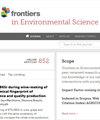硅对土壤磷可用性的影响:得出的结果取决于使用的方法
IF 3.3
3区 环境科学与生态学
Q2 ENVIRONMENTAL SCIENCES
引用次数: 0
摘要
许多土壤中都存在磷的限制,因为土壤中大量的磷以植物无法获取的形式存在,例如与铁(Fe)矿物结合。先前的研究表明,硅(Si)可以从此类矿物的结合位点调动磷。目前已开发出几种钾萃取方法,以考虑不同的钾库。然而,每种方法都使用不同的萃取剂和机制来萃取土壤中不同的钾库。然而,目前还没有研究比较不同的钾萃取方法在施用硅肥的情况下的效果。我们利用两种特性截然不同的土壤,测试了硅对磷迁移率的影响,并测定了水、乳酸乙酸钙(CAL)、Mehlich-III 以及 Bray 和 Kurtz 萃取法在施用无定形二氧化硅(ASi)肥料的情况下萃取磷的效率。与对照组(4 和 10 毫克 P kg-1)相比,高产和低产土壤中 3% ASi 处理(10 和 21 毫克 P kg-1)的水提取物中 P 的含量在萃取 6 小时后明显升高,并随着时间的推移而增加。这可能是因为硅直接与磷竞争吸附在铁矿物上。采用 CAL 萃取法,硅的添加对 P 的萃取率没有影响。相反,Mehlich-III 和 Bray 萃取法显示钾萃取率下降,尤其是在 3% ASi 处理时(95 和 60 毫克 P kg-1)与高产土壤的对照(115 和 80 毫克 P kg-1)相比。Mehlich-III萃取法和 Bray 萃取法发现在有硅存在的情况下 P 含量下降,这可能是由于在萃取硅和铁的同时,萃取剂对 P 的萃取效果下降所致。我们的研究结果表明,Mehlich-III 和 Bray 萃取法可能不适合在施用 ASi 肥料的情况下测定钾的供应量,因为这两种萃取剂也会萃取硅,这可能会限制钾萃取的完整性。因此,在施用硅肥的情况下,水萃取法可能适用于测定钾的可得性和因 ASi 而引起的钾移动。本文章由计算机程序翻译,如有差异,请以英文原文为准。
Silicon effects on soil phosphorus availability: results obtained depend on the method used
Phosphorus limitation occurs in many soils as a significant amount of soil P is retained in forms inaccessible to plants, such as bound to iron (Fe) minerals. Prior studies have shown that silicon (Si) can mobilize P from the binding sites of such minerals. Several P extraction methods have been developed to account for different P pools. Nevertheless, each of those methods uses different extractants and mechanisms to extract different P pools in soils. However, there is no study comparing different P extraction methods in the presence of Si fertilization. We tested the effect of Si on P mobility and determined the efficiency of water, Calcium acetate lactate (CAL), Mehlich-III, and Bray and Kurtz extraction methods for extracting P in the presence of amorphous silica (ASi) fertilization using two soils of contrasting characteristics. Significantly higher amounts of P were found at 3% ASi treatments (10 and 21 mg P kg-1 ) compared to the control (4 and 10 mg P kg-1 ) in the water extract in the high and low-yield soil, respectively just after 6 hours of extraction and increased with time. This may be explained by Si directly competing with P for sorption to Fe minerals. Using CAL extraction, Si addition showed no effect on P extractability. In contrast, the Mehlich-III and Bray extraction methods showed decreasing P extractability, especially at 3% ASi treatment (95 and 60 mg P kg-1 ) compared to the control (115 and 80 mg P kg-1 ) for the high-yield soil. The decreasing P contents in the presence of Si found in the Mehlich-III and Bray extracts may be attributed to the decrease in extraction effectiveness of the extractants to extract P while extracting Si and Fe. Our results showed that the Mehlich-III and Bray extraction methods may not be suitable for the determination of P availability in the presence of ASi fertilization since both extractants also extract Si and this may limit the completeness of P extraction. Therefore, in the presence of Si fertilizer, the water extraction method may be suitable to determine P availability and mobilization due to ASi.
求助全文
通过发布文献求助,成功后即可免费获取论文全文。
去求助
来源期刊

Frontiers in Environmental Science
Environmental Science-General Environmental Science
CiteScore
4.50
自引率
8.70%
发文量
2276
审稿时长
12 weeks
期刊介绍:
Our natural world is experiencing a state of rapid change unprecedented in the presence of humans. The changes affect virtually all physical, chemical and biological systems on Earth. The interaction of these systems leads to tipping points, feedbacks and amplification of effects. In virtually all cases, the causes of environmental change can be traced to human activity through either direct interventions as a consequence of pollution, or through global warming from greenhouse case emissions. Well-formulated and internationally-relevant policies to mitigate the change, or adapt to the consequences, that will ensure our ability to thrive in the coming decades are badly needed. Without proper understanding of the processes involved, and deep understanding of the likely impacts of bad decisions or inaction, the security of food, water and energy is a risk. Left unchecked shortages of these basic commodities will lead to migration, global geopolitical tension and conflict. This represents the major challenge of our time. We are the first generation to appreciate the problem and we will be judged in future by our ability to determine and take the action necessary. Appropriate knowledge of the condition of our natural world, appreciation of the changes occurring, and predictions of how the future will develop are requisite to the definition and implementation of solutions.
Frontiers in Environmental Science publishes research at the cutting edge of knowledge of our natural world and its various intersections with society. It bridges between the identification and measurement of change, comprehension of the processes responsible, and the measures needed to reduce their impact. Its aim is to assist the formulation of policies, by offering sound scientific evidence on environmental science, that will lead to a more inhabitable and sustainable world for the generations to come.
 求助内容:
求助内容: 应助结果提醒方式:
应助结果提醒方式:


